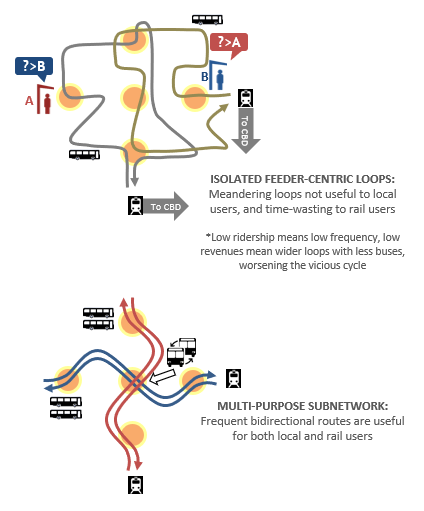Directness of public transport route vis-à-vis auto travel pattern is the best predictor of mode shift potential. A frequent network core must consist of interconnected linear routes.

Linearity increases competitiveness and efficiency
A linear route should be bidirectional (two-way), which is a challenge in planning bus routes onto areas characterized by free-flow road network (bus route fixity problem).
Walking/cycling paths towards the route shall be made as direct as possible, and smaller first last mile vehicles may be introduced to ‘feed’ the route. These two strategies are important to increase the route’s passenger catchment while maintaining its linearity.

Linearity ensures bidirectionality of route and its nodes
Except tourists, people do not generally travel in circles
An efficient route would avoid wide looping route, no matter how attractive the coverage-per-run proposition may be. Passengers on the last segment of a single wide looping route have to get-off and get-on the same bus to get on to the early segment of the same loop.
Given a chance of bidirectional travel opportunities, a person will not travel in a one-way loop. A one-way bus route will never be competitive on a two-way traffic corridor, as the looping pattern penalizes those who begin/end their journey at the start/tail-end of the loop.

Local routes should serve both local destinations and regional-bound rapid transit nodes
Bidirectionality equals usability
If needed, a local bus loop must be limited to either route-ends, and stops along the loop need to be walkable from each other (to maintain route bidirectionality).
If there’s still a need to go for a single wide looping route, it has to be a bi-directional continuous loop. Driver or vehicle shift transitions need to be timely pulsed, so as not to penalize end-of-loop users who are headed to start-of-loop destinations.

Loop size should be kept as minimum as possible
Orbital bidirectional loops as result of through-routing
The need for city or metropolitan-scale bidirectional loops can result from continuous orbital travel demand along the periphery ring that surrounds a main urban centre. Opposing directions are simply coined as Clockwise and Counter Clockwise. Orbital bus lines take advantage of the through-routing principle, which will be explored under the Simplicity Chapter.

Examples of bidirectional orbital and near-orbital bus routes serving inner and outer periphery of downtown Auckland, Greater Dublin and Greater Melbourne (maps from Aukland Transport, Dublin’s NTA and Melbourne’s PTV)
Road grids and network linearity
In absence of a true grid-based road network, bidirectional and linear routes can be difficult to carve. Fortunately, plenty of measures can be adopted to make the present road traffic infrastructure to be more accommodating to buses. In areas where accommodations can be hard (e.g. narrow streets, low clearance tunnels), smaller or more nimble public transport modes can be considered, especially if the surrounding urban density does not justify the cost of infrastructural accommodation.

Examples of measures to form linear, grid-based bus network